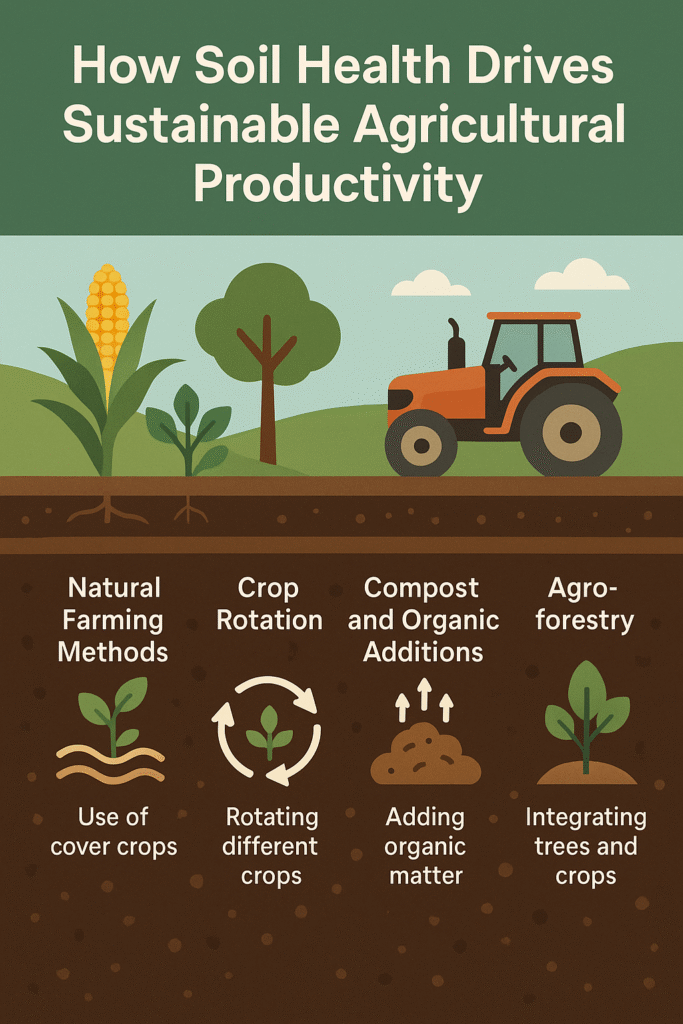Let me tell you something simple but powerful about Soil Health – soil is life. Everything we grow—every fruit, grain, and vegetable—starts with healthy soil. But we don’t often treat it like the vital, living system it is.
When I talk about soil health, I’m not just referring to dirt. I’m talking about a rich, active ecosystem that fuels the growth of our food, stores carbon, filters water, and supports biodiversity. And if we’re serious about sustainable agriculture, protecting our soil is where we must begin.
Why Soil Health Matters So Much
Healthy soil is more than a farming tool—it’s a foundation. Think of it as the engine of agriculture. Without it, crops weaken, pests flourish, and farmers struggle. But when soil is full of organic matter, microbes, and nutrients, it’s self-sustaining.
Unfortunately, decades of erosion, chemical overuse, and compaction have pushed many soils to the brink. What happens then? Farmers turn to synthetic fertilizers and pesticides to compensate. That’s a dangerous cycle—one that’s expensive, polluting, and ultimately unsustainable.
The USDA calls soil health “the continued capacity of soil to function as a vital living ecosystem.” That definition says it all.
Using Natural Farming to Revive Soil Health
One of the best decisions we can make is to return to natural farming methods. For example, I’ve seen firsthand how cover crops like clover or rye keep soil in place, suppress weeds, and even feed the soil with carbon and nitrogen.
These crops aren’t just fillers—they’re essential tools for soil regeneration. Legumes, especially, help fix nitrogen in the ground, which reduces the need for chemical fertilizers.
Want to learn more? Rodale Institute has studied these techniques for decades and found they often outperform conventional methods over the long term.

Crop Rotation: A Time-Tested Strategy to Improve Soil Health
Another technique I use is crop rotation. It’s simple: don’t grow the same thing in the same spot year after year. When I switch between crops like corn and soybeans, or cereals and legumes, I disrupt pest cycles and balance soil nutrients.
This isn’t a new idea. Indigenous communities around the world have used rotational farming for centuries. It’s smart farming—and it’s sustainable.
For tips on crop rotation plans, check out NRDC’s sustainable agriculture page.
Compost and Organic Additions
Want to boost yields without chemicals? Start composting. I add organic matter like food waste and farm scraps into compost piles. The result? A rich, dark, crumbly material that feeds soil microbes and retains water.
Healthy compost doesn’t just build fertility. It builds resilience, helping soil withstand droughts, floods, and other climate pressures. Learn more about composting basics from the EPA here.
Agroforestry: Planting Trees to Protect Soil Health
You might be surprised to hear this, but planting trees among your crops or livestock—a system called agroforestry—does wonders for soil.
Trees provide shade, drop leaf litter that turns into organic matter, and stop erosion. Their roots hold soil in place and support underground biodiversity. It’s one of the most holistic approaches I’ve used to regenerate land.
If this piques your interest, explore Regeneration International’s agroforestry resource for global success stories.
Policy and Education Must Play a Role
Even with all these tools, we still need support. That means government incentives, farmer education, and public investment in soil health. Programs that offer soil testing, technical training, and rewards for sustainable practices can make a big difference.
The truth is, regenerative farming should be the norm, not the exception. And with the right support, it can be.
Let’s Bring Soil Health to the Center of Agriculture
So what’s the takeaway? Soil health is the future of farming. It’s the key to growing more food, protecting biodiversity, cutting emissions, and creating climate-resilient landscapes.
If you’re ready to start your journey toward a more sustainable farming model, I invite you to explore our community.
Join the EAT Community to connect with experts, learn best practices, and gain access to webinars, tools, and training focused on ecolonomic living—where we make a little money making the planet better
References & Related Articles
- Regenerative Agriculture: Boosting Soil Health and Carbon Sequestration
- Organic Matter Rich Soil is a Healthy Living Soil
- USDA Soil Health Overview – Learn what makes soil healthy and how to maintain it.
- Rodale Institute Farming Systems Trial – See long-term comparisons of organic and conventional farming.
- NRDC: Sustainable Agriculture – Explore strategies to protect soil and water.
- EPA: Composting at Home – Turn your waste into nutrient-rich compost.
- Regeneration International: Agroforestry – Discover how trees and farming can work together.



